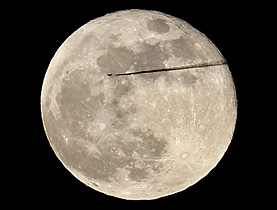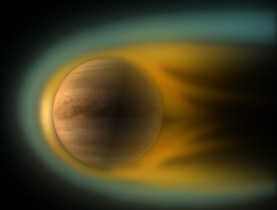Moon research takes small step

If beauty is only skin deep, the same can be said for the attributes of moons and planets. Researchers have peeled off a layer to better understand their origins.
Swiss and Swedish scientists have for the first time received data from instruments installed on a satellite that reveal how the moon’s surface is altered by solar winds – the highly-charged particles emitted by the sun.
The information helps unravel the physical processes that influence the formation and evolution of bodies in space.
This new knowledge, coupled with what is already known from tests done on lunar samples, will allow scientists to begin investigating the original composition of moons and asteroids, ultimately pointing to the earliest materials that formed planets.
Moons are interesting to study, according to Peter Wurz of Bern University’s Space Research and Planetary Sciences department, because they are essentially “small, unprocessed material”.
This is in contrast to planets that have evolved greatly over time due to the mixing and processing of their chemical components. That is why Earth and Mars, two planets relatively close together and about the same size, look completely different.
On the other hand, asteroids, Wurz told swissinfo.ch, “are witnesses to early history – the beginning of our solar system”.
Wurz’s department developed the cutting-edge hardware for the instruments placed on India’s Chandrayaan-1 satellite.
These Swiss-made parts are unique in that they can detect neutral atoms – key to measuring accurately the effect on the moon’s surface of the solar wind.
Chemical bonds
“These [solar wind] particles are so fast that the impact causes damage, releasing atoms that change chemical bonds and alter the top-most surface,” Wurz explained.
“If you don’t understand the alteration, you don’t understand what’s underneath.”
The moon was chosen for studying the impact of solar wind because it lacks, in great part, magnetic fields and an atmosphere that, in the case of the Earth, act as a shield against the highly charged particles.
Once the alterations have been deciphered, scientists will be able to use the data to calculate how surfaces have changed over time, and therefore, be a step closer to deducing the original composition of bodies in space.
Space weathering
To study the effects of space weather in our solar system, Wurz said scientists must assume forces at work on the moon or on asteroids are the same. The intensity of those forces should be scaled according to their distance from the sun.
“You know how the space weathering altered the original surface of the moon to what is now observed,” he explained.
Take an asteroid, for example. One that has been subject to extensive space weathering will see its colour shift as its composition changes. To find out what happened, scientists, like painters, can take the minerals known to be in the solar system, mix them to produce the original colour, and deduce the asteroid’s earliest composition.
Wurz admitted that the latest knowledge represents only a small piece in a very large puzzle, but “if you add one piece after another, you see more.”
Dale Bechtel, swissinfo.ch
The Swiss-developed hardware is part of the Sara instrument mounted on the Chandrayaan-1 satellite.
Sara consists of three measuring devices: an imaging mass spectrometer, a solar wind monitor and digital processing unit.
Together, they imaged the moon’s surface composition including the permanently shadowed areas, measured the solar wind-surface interaction and the lunar surface magnetic anomalies.
Institutes involved in the moon study expect to carry out similar observations on Mercury as early as 2014.

In compliance with the JTI standards
More: SWI swissinfo.ch certified by the Journalism Trust Initiative














You can find an overview of ongoing debates with our journalists here . Please join us!
If you want to start a conversation about a topic raised in this article or want to report factual errors, email us at english@swissinfo.ch.